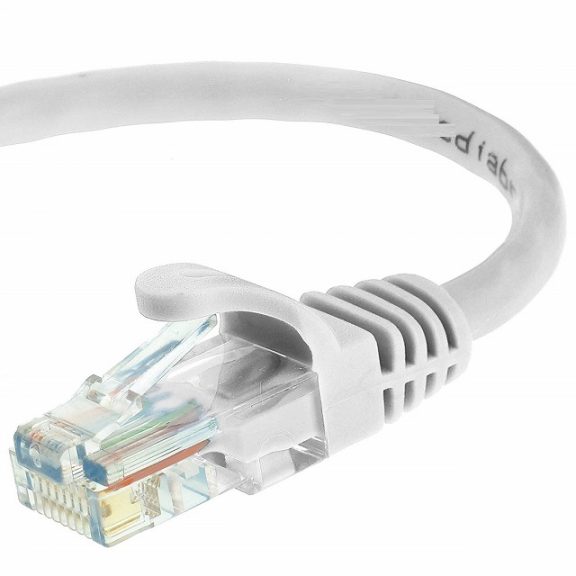Choosing a proper Ethernet wire for a home or business network is very essential. The maximum speed, cost, and the length and type are some factors that you need to consider while choosing Cat5e Vs Cat6. As cost can’t differentiate these two, you have to focus on the features of both.
The Cat6 wires have a “spline” that is a longitudinal separator. It helps to make the cable more durable and prevents it from stretching. The spline makes the line more rigid. A few category6 wires are there that feature separate shielding.
While you are going to select the best wires, you may face multiple questions in your mind like what is the network speed it offers: 100 Mbps, 1000 Mbps, or 10 Gbps? How many people have used it already? Is this wire suitable for indoor or outdoor use? Should the wire be rigid? And so on.
I suggest that we should not invest money on such higher performing wires like category 6. It is because the recent hardware in the network infrastructure doesn’t need 10 Gbps speeds. However, it is easier to upgrade hardware than to upgrade any new wires. However, you can differentiate these two depending on a 100% copper quality cable.
You should always look for those suppliers who can offer ETL-Verified wires, like Black Box. Besides, you can see many acronyms like for shield look for the “S ” in the category. Category 6 wire is more reliable compared to category 5 and 5e cables. But the category6 line is compatible with Cat 4.
What is CAT5e Cable?
We know CAT5e as Category 5e or Category 5 Enhanced. This network cable was ratified in 1999. Compared to the older version, this Category 5e includes up to 10 times faster speed. This twisted-pair line has been commonly in use since 2001. The cable used to carry the signals of video and telephony. Its 24-gauge twisted pair wires are suitable to support Gigabit networks.
Usually, home routers offer us network speeds of 10 or 100 megabits per second. People prefer to use Gigabit Ethernet routers nowadays. All cables from old to new Category 5e support Gigabit Ethernet. The old version of the category 5e cable is no longer a recognized standard. But still the line can support gigabit speeds. Developers made the new version of the category 5e wire to offer increased gigabit speeds.
What is CAT6 Cable?
Most of the people use the Category 6 cable as it is a standardized twisted pair wire. It is perfect to use for an Ethernet network. The wire supports Category 3 and Category 5/5e cable standards. It has a lot more specifications like a reduced noise system compared to Category 5 and 5e.
CAT6 that we know as Category 6 released in the market merely some years later of category 5e. For the Category 6 cable, the network can support for only 55 metres (180 ft) length while it is used for 10GBASE-T,. When you work on a system using category6 wire, you will get less error. However, some people complain that these ones are hard to install and use.
The cables can be twisted to insulate it more than previous. These cables can support the Gigabit Ethernet segments up to 100 m. You can use 10-Gigabit networks in a limited distance.
CAT5e vs CAT6
Bandwidth
Both types of cables can handle up to 1000 Mbps or 1 Gigabit per second. You won’t get a poor internet connection of up to 500 Mbps speed using the cable.
However, the main difference between these two wires is the bandwidth. We can differentiate them depending on the data transfer speed. Category 5e wires designed to operate frequencies up to 100 MHz Whereas category6 can operate up to 250 MHz It means that a category 6 wire can transfer more data at the same time. Both cables can offer you equal speed. But a 4-lane highway contains more traffic at the same time than the 2-line highway.
Wire size
The CAT 5 cables have a total of eight wires that have a 24 gauge diameter. It is a smaller wire compared to other electronic cables. The small diameter wires that used for network Communications depend on low voltage signals.
On the other side, the category6 can be operated at 250 MHz frequency. It has four twisted pairs of copper wire. The size of the cables is 23 AWG gauge.
Max Speed
Category6 wires can offer up to 10GBASE-T or 10-Gigabit Ethernet speed as the cables can operate up to 250 MHz. The frequency is more than 2× of category 5e cable that supports up to 1GBASE-T or 1-Gigabit Ethernet. Both of these wires are compatible with the same RJ45 end-connectors that are used for home and business networking. People use a few short names i.e. acronyms are as follows: “TP” for twisted pair, “S” for the shield, and “U” for un-shielded.
When it comes to defining Cat5e vs Cat6 according to their performance, it can be said that both wires support 1Gbps transfer speeds. It is sufficient for most home networks. For the users who need high-bandwidth cables in their homes or offices, both of these two offer faster connections. Category6 gives the best performance at higher bandwidth at shorter wire lengths.
But these are still smaller than the average HDMI cable. For example, the category 5 wires can support any device of up to 10Gbps at up to 55 meters. It comes with a complete package for all home users. However, for those who need a fast network with plenty of bandwidth can use category6 cable to transfer data. But make sure that the wires should not be too long.
Cross-talk
Category 6 cables offer 250 MHz performance because of using a nylon spline in the wiring. It consists of high isolated twisted pairs that turn it into a rigid line. In recent times, these cables are very flexible and decrease Boise while performing. This useful cable gives Near-End Cross-talk (NEXT) in the transmission. Besides, it assists in improving the Equal-Level Far-End Cross-talk (ELFEXT), Return Loss (RL), and Insertion Loss (IL). Using cross-talk, you can get fewer system noise, higher data transmission rates, etc.
Maximum Length
Both the category 5e and category6 can support network speeds up to 100 m per network segment. That’s why you should not cross the limited network area. Otherwise, you will not get a proper connection. However, if you want to cover more than 100 distance, you need to amplify the signals with repeaters or switches.
The maximum length that the category6 wire can support for 10/100/1000BASE-T is 328 ft. Here, you can see a robust “horizontal” cabling between the patch panel and the wall jack. And it also consists of a 16 ft long useful patch cable between each jack and the attached device.
When it comes to defining CAT5e vs CAT6 based on their Visual differences, the category of wire is usually printed in the cable. In case the type of the line is not printed on the wire, then you can’t identify the category of the wire by color or RJ45 connector. In the category 6 lines, there exist thicker copper wires than CAT5e.
Cost:
You can get the category 5 cables at about $9. But it is only for the wires that can support a network up to 100 ft. If you want to buy a Cat6 cable of 100 feet, then it will cost more than $11. These Ethernet wires are very costly because of their quality materials, copper.
Usually, when you buy the Category 6 cables, you will find this 10-20% costlier than Category 5e cables.
Conclusion:
If you want to set up a home network or willing to replace old wires or increase your workplace LAN, then the category6 wires can do the job easier for you. People who want faster data transfers with more durability can choose it. These cables are useful for insulation against cross-talk and internal noise.
However, you should also know that all networks will support the category6 wires. In case you don’t have such a device that can support 10Gb networking, then you should not use a category6 cable. That’s why if you are thinking of buying Cat5e Vs Cat6, we will recommend you to choose Category 6 cable.
Frequently Asked Questions:
- Can I use Cat6 instead of CAT5e?
A category6 cable has eight twisted copper wires that are similar to a Cat 5 Ethernet cable. However, you can get more benefits from the category6 line. This wire contains a bandwidth capacity of 250 MHz and can offer speeds of up to 10 Gbps. It also supports both Category 5 and 5E cables.
- Should you use Category 5 cable for 4k?
Whether it is the older version cat5 or the new category, you can use both of these. Category 5 cable can easily handle the gigabit speed that makes it perfect for 4k.
- Is Cat 7 quicker than category6 cable?
Compared to category 6 cable, Cat 7 has a higher frequency that implies the number of signals passed through the line. It can transfer 10,000 Mbit data per second at a frequency of 1,000 MHz. That’s why a cat7 can transfer data quicker than a Category 6 cable.
- Which one is the best cat cable?
The Category of the best cat cables are as follows:-
Cat5 – It is outdated and hard to find.
Cat5e – This cable is new in the market.
Cat6 – This wire contains a higher bandwidth.
Cat6a – It has 10x greater speed and two times higher bandwidth.
Cat 7 – Bandwidth is a little bit higher than Category 6a wire.
Cat 7a – It is the best and costliest one.







